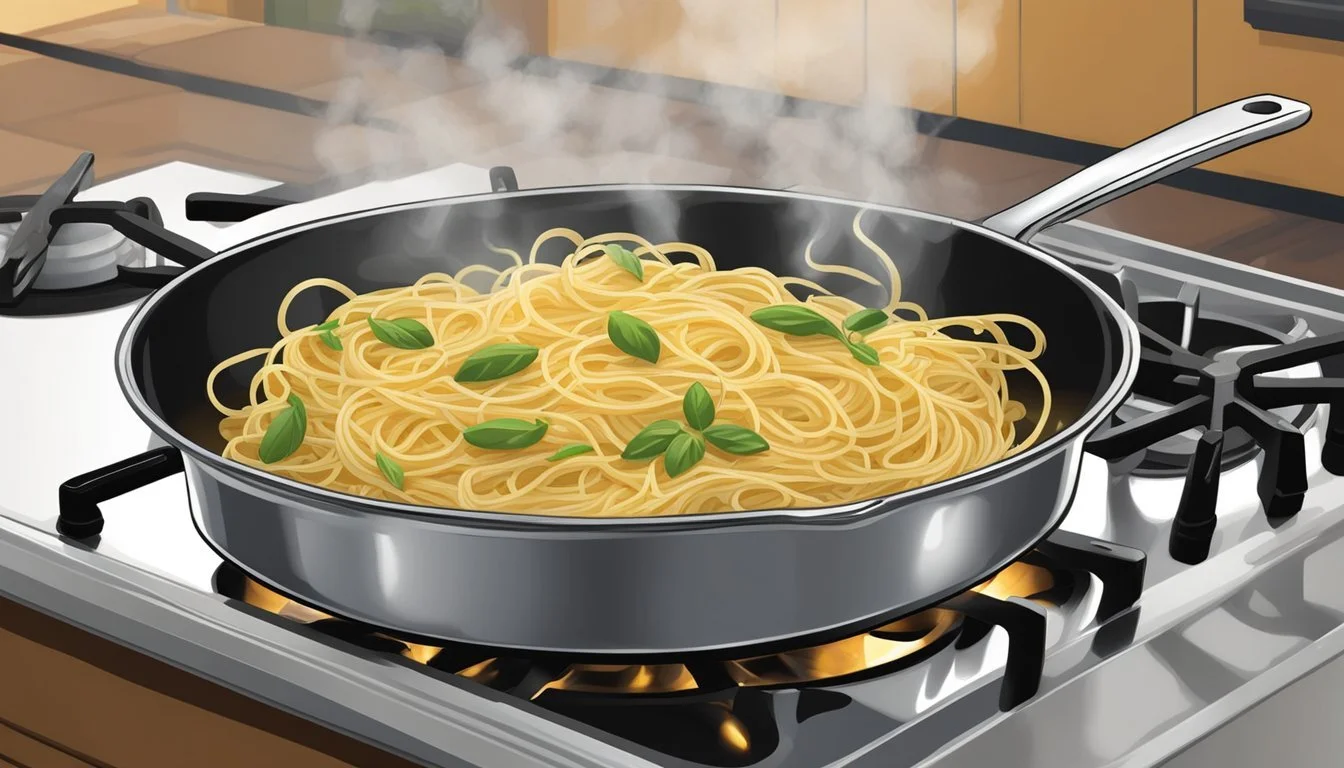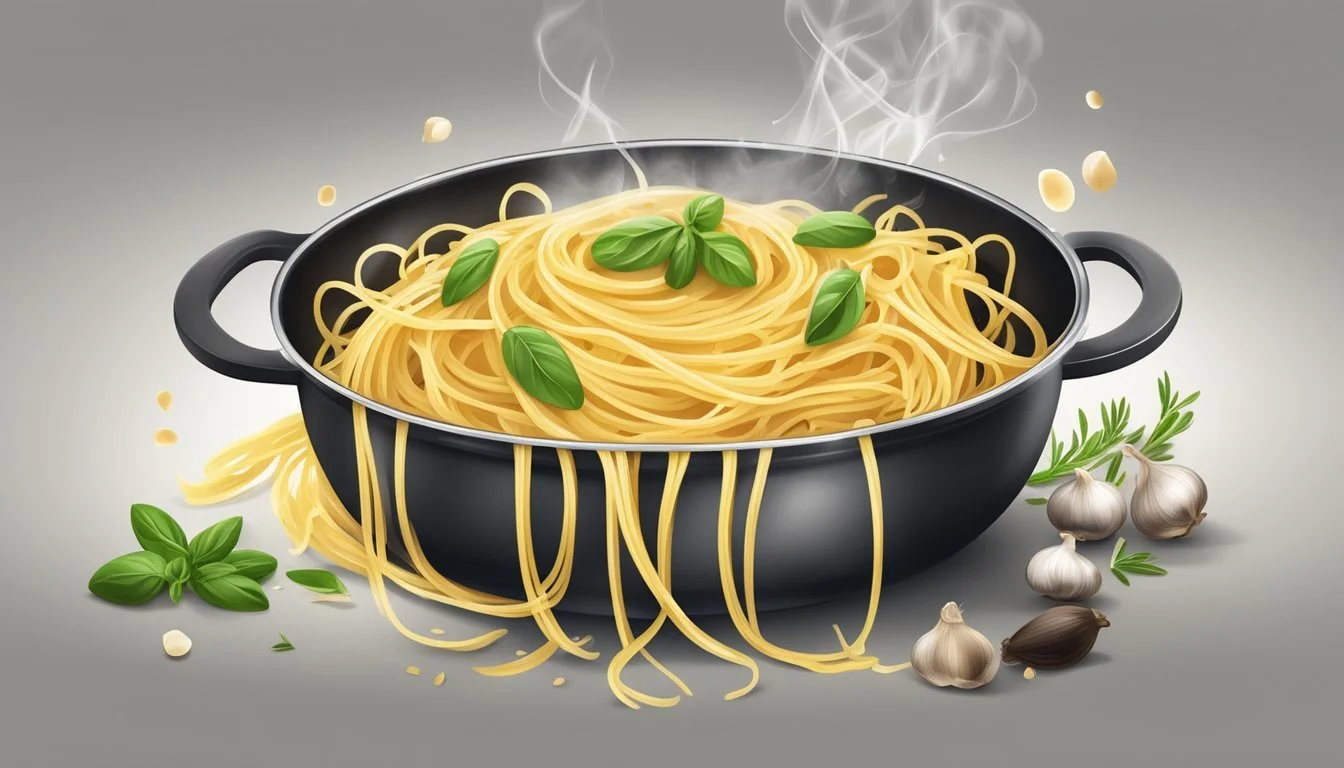Best Way to Reheat Spaghetti with Olive Oil and Garlic
Ensuring Al Dente Texture and Robust Flavor
When it comes to enjoying leftover spaghetti, the challenge is often in preserving the texture and enhancing the flavors of the original dish. A common dilemma is keeping the pasta (What wine goes well with pasta?) al dente and the garlic (What wine goes well with garlic?) taste as pronounced and delightful as when it was first cooked. The key lies in the method used for reheating the pasta, which can make the difference between a soggy disappointment and a revived, delicious meal that's almost as good as fresh.
Reheating spaghetti with olive oil and garlic requires a technique that gently warms the pasta without overcooking it, retaining the firmness of an al dente texture. Additionally, the method must support the re-infusion of the fragrant garlic flavor. With a focus on these objectives, there are a few recommended techniques that ensure the pasta comes out of the kitchen steaming with flavor and perfect consistency, well-suited for a second serving.
Understanding the Composition of Leftover Pasta
When reheating spaghetti with olive oil and garlic, it's important to consider how pasta's structure and the retention of oil and garlic flavors will affect the outcome.
The Structure of Cooked Pasta
Cooked pasta consists of starch molecules that have swollen with water and heat, making the noodles soft and flexible. Plain pasta, once cooled, undergoes a process called retrogradation, where the starches crystallize and firm up, causing the pasta to become firmer and potentially lose its al dente texture. When reheating spaghetti, particularly if it's plain pasta without sauce, one must carefully apply heat to return it to a desirable texture without overcooking.
Olive Oil and Garlic Flavor Retention
Reheated pasta with sauce, especially one made with olive oil and garlic, can present unique challenges in flavor retention. Olive oil serves as a flavor carrier, but it also has a low smoke point which can cause it to break down if overheated, potentially leading to a loss of its rich, fruity essence. Garlic retains its flavor well but can become bitter if overcooked. Leftover pasta that includes these aromatic ingredients should be reheated gently to maintain the integrity of the flavors infused by the olive oil and garlic.
Reheating on the Stovetop
The stovetop method offers an excellent way to reheat spaghetti while preserving its al dente texture and infusing the garlic flavor. A skillet or saucepan is typically utilized to achieve the desired reheating results.
Using a Skillet for Al Dente Results
To maintain the al dente texture of spaghetti, one should use a skillet over medium heat. It is important to:
Heat the skillet before adding the pasta.
Add a small amount of water or olive oil to prevent sticking.
Stir the pasta gently and frequently to heat it evenly.
This ensures that the pasta doesn't overcook and stays al dente.
Reheating Pasta with Sauce
When reheating pasta that has already been mixed with sauce, the process requires a saucepan over low to medium heat. The steps involve:
Placing the pasta and sauce in the saucepan.
Adding a splash of water to loosen up the sauce.
Covering the saucepan with a lid to create steam and avoid drying out.
The pasta should be stirred occasionally until it is heated through.
Sauteing Garlic to Avoid Bland Taste
To boost the flavor of reheated pasta with garlic, one should:
Begin by heating a tablespoon of olive oil in the skillet.
Add minced garlic and sauté until it's golden brown.
Mix in the spaghetti to coat it with the garlic-infused oil.
Sautéing garlic ensures a burst of flavor without the blandness that sometimes accompanies reheating.
Reheating in the Oven
Reheating spaghetti in the oven is an effective method to ensure the pasta remains al dente while infusing the garlic's aroma and preserving its flavor. Using this approach, one can revitalize day-old pasta as close as possible to its original taste and texture.
Pre-heating and Preparation
Before reheating begins, the oven should be pre-heated to 350 degrees Fahrenheit, which is the optimal temperature for warming pasta without overcooking it. Next, an oven-safe baking dish should be selected to accommodate the amount of spaghetti being reheated. It is recommended to lightly grease the dish with olive oil, which prevents sticking and contributes to the dish's flavor profile.
Layering Pasta with Additional Ingredients
Transfer the spaghetti into the baking dish, spreading it out evenly. For enhanced flavor, one may consider drizzling additional olive oil over the pasta. This helps maintain the pasta's moisture during the heating process. If the spaghetti was originally served with garlic, lightly sprinkle some freshly minced garlic on top, for a renewed burst of flavor that will permeate the dish as it heats.
Preserving the Garlic Flavor During Baking
To effectively retain the garlic flavor and prevent it from becoming bitter, the dish should be covered with aluminum foil. This creates a steamy environment within the baking dish, allowing the heat to circulate gently and the garlic aroma to infuse into the pasta. The spaghetti should be checked periodically, gently stirred, and returned to the oven until thoroughly heated. This method ensures that the garlic does not burn and that the pasta stays moist and delicious.
Reheating Using a Microwave
When reheating spaghetti with olive oil and garlic in a microwave, the key is to preserve the pasta's al dente texture and the garlic's flavor. This section outlines the pivotal role of water in this process and the best microwaving techniques to achieve even heating.
The Role of Water in Microwave Reheating
In microwave reheating, a splash of water is essential to prevent the pasta from drying out. This is because the water turns into steam, creating a moist environment that heats the pasta gently and helps maintain its al dente texture.
Before heating, one should lightly drizzle the spaghetti with water.
Spread the spaghetti evenly in a microwave-safe dish to allow for uniform absorption of moisture.
Microwaving Techniques for Even Heating
For even heating in the microwave, specific techniques must be applied:
Placement:
Place the microwave-safe dish in the center of the microwave to promote uniform cooking.
Covering:
Use a microwave-safe lid or plastic wrap to cover the dish, ensuring steam distribution which carries heat into all parts of the spaghetti.
Interval Heating:
Heat the spaghetti in intervals of 15-30 seconds, stirring between each interval to distribute the warmth evenly.
Temperature Setting:
Microwave at a medium heat setting to avoid overheating the garlic, which may lead to a bitter taste.
By applying these techniques with care, one can achieve well-heated spaghetti with preserved qualities.
Additional Tips for Enhancing Flavor and Texture
To ensure the spaghetti with olive oil and garlic retains its al dente texture and garlic is flavorful, incorporating cheese and herbs, as well as maintaining the crispness of add-ons are crucial.
Using Cheese and Fresh Herbs
Sprinkling finely grated Parmesan or mozzarella can infuse the spaghetti with a deeper flavor and richness. Cheese not only adds a savory note but also contributes to a desirable texture. For an aromatic lift, one should fold in fresh herbs like basil or parsley right before serving. This keeps the herbs vibrant and impactful on the palate.
Cheese: Add while pasta is warm for optimal melting.
Parmesan: Sharp and salty, it enhances the garlic flavor.
Mozzarella: Provides a gooey, mild contrast to the robust olive oil and garlic.
Fresh Herbs: Toss in at the end to preserve their freshness.
Basil: Adds a peppery, slightly sweet note.
Parsley: Introduces a light, crisp freshness.
Maintaining Crispness in Add-ons
For any add-ons that are meant to be crisp, such as pancetta or breadcrumbs, they should be reheated separately to maintain their crunchy texture. Adding them to the pasta after reheating ensures they don't become soggy and retain their crisp bite which is part of the overall sensory experience.
Crisp Add-ons: Sauté separate; combine after reheating.
Pancetta: Should be golden and crunchy.
Breadcrumbs: Toast until golden for an extra crunch.
Safety and Storage Considerations
When preserving the quality of spaghetti with olive oil and garlic, understanding the correct safety and storage practices is crucial. These methods ensure the pasta remains al dente and the garlic retains its flavor upon reheating.
Proper Storage Methods for Leftovers
Leftovers should be cooled to room temperature within two hours of cooking to prevent bacterial growth. Once cooled, leftover spaghetti with olive oil and garlic should be transferred to an airtight container. It is vital to store the container in the refrigerator if the pasta is to be consumed within the next three to four days. Refrigeration is essential to maintain both safety and the quality of the leftovers.
Freezing and Reheating Frozen Pasta
For longer-term storage, spaghetti with olive oil and garlic can be frozen. To do this effectively, one must:
Allow the pasta to cool.
Portion the spaghetti into suitable freezer bags or containers.
Label the bags or containers with the date of freezing.
Gently press out excess air before sealing to prevent freezer burn.
When it's time to reheat the frozen pasta, it should be thawed in the refrigerator overnight before reheating to ensure even warming while retaining its al dente texture and the flavorful garlic.
Conclusion
Reheating spaghetti while maintaining its al dente texture and enriching it with the essence of olive oil and garlic requires a careful balance of technique and temperature control. One should ensure that the pasta is heated gently to avoid overcooking.
When reheating, add a small amount of olive oil to a pan to prevent sticking and preserve the pasta's texture.
Use fresh garlic to infuse the dish with flavor, adding it to the oil before the pasta to release its aroma without burning.
To keep the noodles al dente, stir occasionally, and monitor the heat closely.
The best results are achieved by reheating at a medium heat, which warms the spaghetti thoroughly without overcooking or drying it out.
For those preparing pasta dinners in advance, this method guarantees that each meal retains the quality and taste of freshly cooked pasta recipes. A gentle and attentive approach to reheating spaghetti ensures a satisfying pasta dinner, showcasing the subtle flavors of olive oil and garlic.






